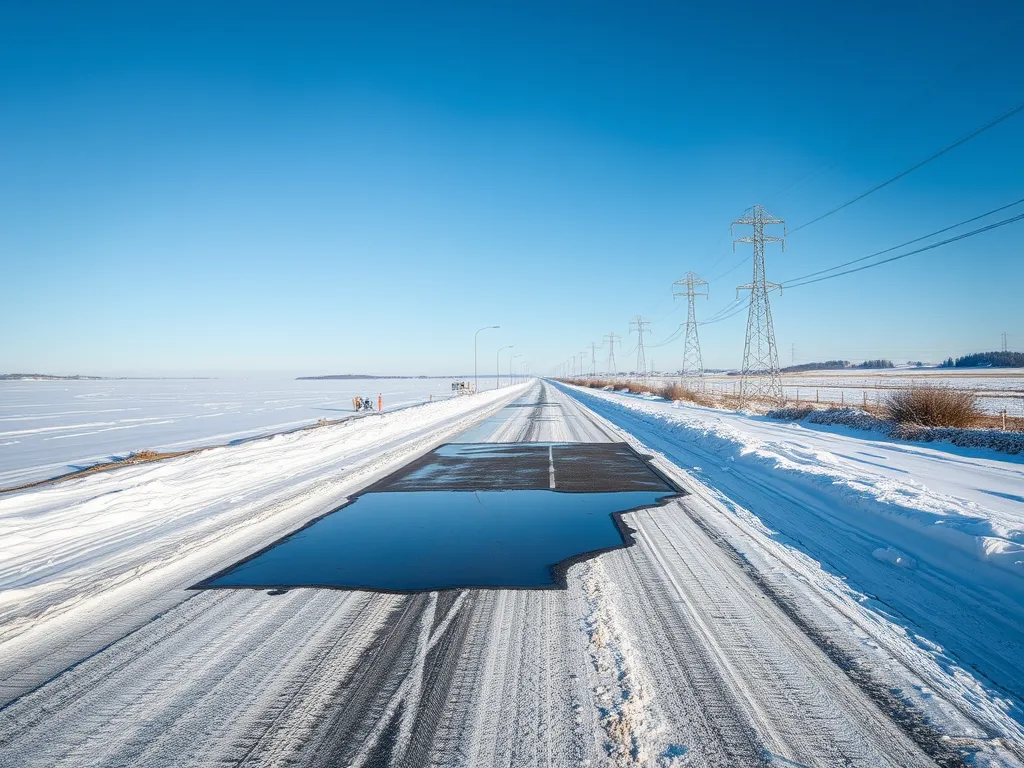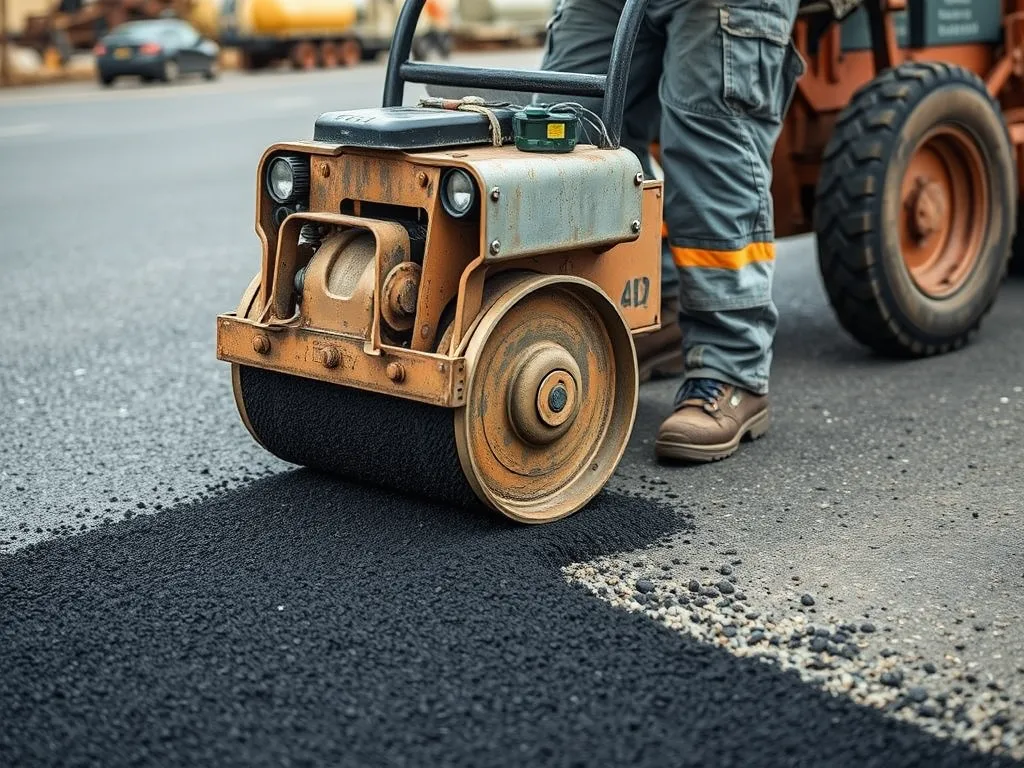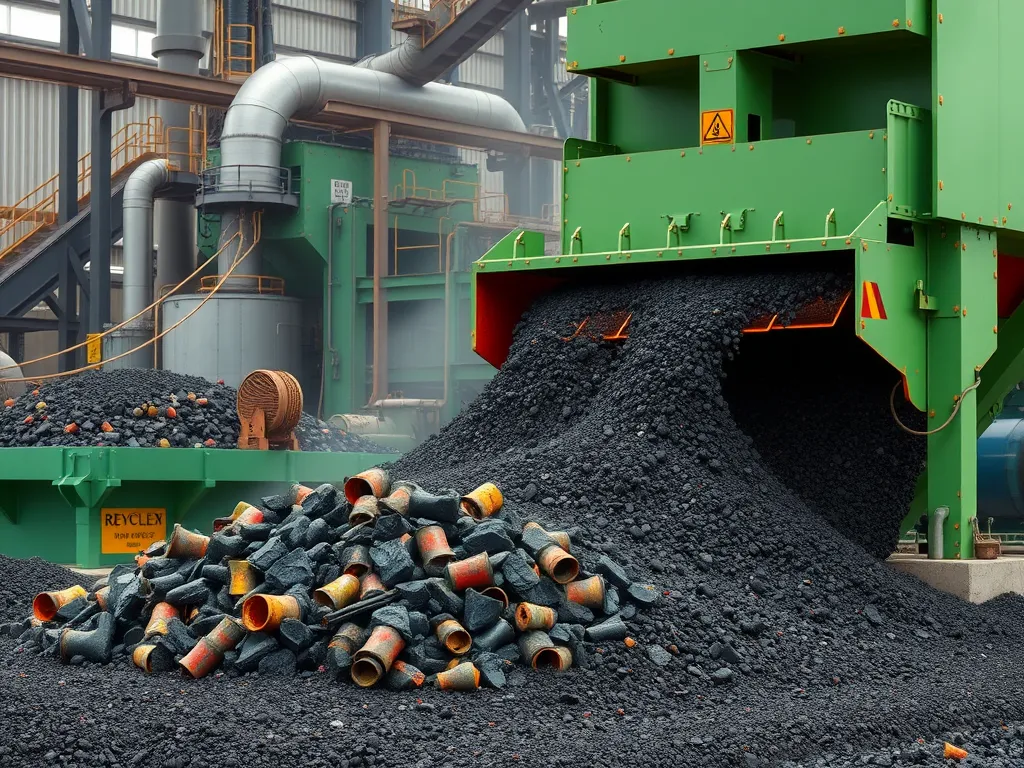Can You Heat Cold Patch Asphalt? A Practical Guide
Published on: October 4, 2025 | Last Updated: April 14, 2025
Written By: George Voss
Yes, you can heat cold patch asphalt if you follow manufacturer guidelines and safety protocols. Unlike hot mix asphalt requiring 300°F production temperatures, cold patch uses pre-coated aggregates and emulsified binders for ambient installation. Heating it to 150-200°F improves workability in cold weather but requires precise control – propane torches, heat guns, or hot water baths work best. Always test small batches first to avoid breaking the petroleum-based binders.
This guide covers heating methods that boost winter performance without compromising material integrity. We’ll explore temperature limits, compare torch vs electric heating options, and share compaction tricks for durable repairs. Learn why summer applications rarely need heat, how to spot overheating risks, and when to choose hot mix instead for permanent fixes.
Contents
- What is Cold Patch Asphalt?
- Can You Heat Cold Patch Asphalt?
- Why Heat Cold Patch Asphalt?
- Methods for Heating Cold Patch Asphalt
- Seasonal Considerations
- Application Process for Heated Cold Patch
- Post-heating Considerations
- Environmental Impact &Amp; Best Practices
- Cold Patch Asphalt Heating FAQs
- Final Words
- Additional Resources for You:
What is Cold Patch Asphalt?
Cold patch asphalt serves as a ready-to-use repair material for asphalt surfaces. Unlike traditional hot mix, it requires no heating equipment or special preparation. Made from aggregate coated with emulsified asphalt or solvent-based binders, this material stays pliable in bags until applied. Common brands like QPR or EZ Street dominate the market for temporary and emergency repairs.
Definition and Common Applications
Cold patch asphalt works best for quick fixes on roads, driveways, and parking lots. Typical uses include filling potholes, sealing cracks up to 1-inch wide, and repairing utility cuts. Contractors favor it for projects needing rapid completion, especially during winter months when hot mix plants shut down. Municipalities stockpile cold patch for snowplow-damaged roads, while homeowners tackle DIY projects like driveway edge repairs.
Key Differences Between Cold Patch and Hot Mix Asphalt
Cold patch and hot mix asphalt differ fundamentally in composition and installation. Hot mix requires heating to 275-325°F at asphalt plants for proper binding, while cold patch uses modified binders that activate at ambient temperatures. Cold patch achieves 85-90% compaction through hand tamping versus hot mix’s 95%+ density from steamrollers. Though hot mix lasts 8-12 years versus cold patch’s 2-5 years, the latter’s convenience drives its use in low-traffic areas.
With these distinctions in mind, let’s examine why heating cold patch asphalt sparks debate among professionals.
Can You Heat Cold Patch Asphalt?
Cold patch asphalt works without warming in most situations. But many ask: can warming boost its function? Short answer: possibly – if done right. Outcomes vary by product formula and application goals.
Understanding Manufacturer Guidelines
Brands like QPR or EZ Street build cold patch with cutback asphalt or polymer additives. Most labels say “no warming required.” But some allow mild warming up to 140°F (60°C) in frosty air. Check technical datasheets first – violating limits can split binders, making material fail. For instance, Aquaphalt 4.0 warns against any warmth, while RoadRok permits torch work below 160°F.
Pros and Cons Of Heating Cold Patch
Adding warmth aids in three ways: softens mix for smooth spreading in sub-40°F air, boosts stick to old blacktop, and speeds curing from 3 days to 24 hours. Downsides? Torch jobs risk fires if done near fuel or dry grass. Overcooking past 180°F burns off oils, causing cracks. Costs climb too – propane tanks for torching run $25-$50, though labor hours drop.
Workers using infrared guns spot-check temps should aim for 110-135°F for best packing. A Wisconsin road crew found heated cold patch repairs last 2-3 years vs 1 year unheated in snow zones. But in Phoenix trials, warmed patches showed no gain in summer – natural 90°F air did the job.
Up next: Why warming might fit your fix job – from frosty fills to traffic rush needs.

Why Heat Cold Patch Asphalt?
Cold patch asphalt works without warming in most situations. But applying warmth brings distinct advantages for lasting fixes. Let’s look at three main reasons to add a bit of warmth.
Improving Workability in Cold Conditions
Cold patch stiffens as air drops below 50°F (10°C). Warming it to 70-90°F (21-32°C) cuts viscosity by up to 40%, making it moldable for filling cracks or potholes. Think of it like softening clay—warmer material fills voids fully without crumbling at -edges.
Boosting Adhesion for Long-lasting Fixes
Bitumen in cold patch bonds poorly on damp or frosty surfaces. Warming both patch and ground lifts moisture, allowing tight contact. Tests show heated cold patch asphalt grips 2-3x better than unheated in 35°F (2°C) conditions. This stops water from working under repairs.
Speeding Up Solidification
Typical cold patch takes 2-4 days to harden for cars. Warming cuts this to 6-12 hours by pushing oxidation. A propane torch can lift surface temps to 140°F (60°C), locking aggregates fast. Just avoid going past 185°F (85°C)—bitumen starts breaking down.
Knowing why warmth aids cold patch sets up smart choices. Next, let’s look at ways to add that warmth without harming material.
Also See: Asphalt Alternatives for Businesses
Methods for Heating Cold Patch Asphalt
Heating cold patch asphalt requires precision. While designed for ambient-temperature use, gentle warming boosts performance in specific scenarios. Select methods based on equipment access, repair size, and weather conditions.
Controlled Heating Techniques
Four proven methods balance safety with effectiveness. Each targets material temps between 150°F and 250°F to activate binders without degrading bitumen.
Torch Heating (Propane or Butane)
Propane torches work for spot repairs. Hold the flame 12-18 inches above the material, sweeping steadily to prevent scorching. Limit exposure to 30-second intervals per area. Butane torches offer lighter heat for smaller jobs. Always wear heat-resistant gloves and ventilate the space.
Heat Gun Application
Industrial heat guns (1400W+) provide focused airflow at 200-400°F. Maintain a 6-inch distance using circular motions. Takes 2-3 minutes per square foot. Ideal for driveways or curbs where open flames pose risks.
Hot Water Bath Method
Submerge sealed cold patch bags in 160°F water for 30 minutes. Avoid boiling to prevent packaging splits. Works best for pre-heating material before transport to the job site. Drain excess water before cutting the bag open.
Electric Blanket Warming
Wrap asphalt chunks in a heavy-duty electric blanket set to 150°F. Takes 1-2 hours for uniform heating. Useful for large batches in cold climates. Check material pliability every 20 minutes.
Safety-critical Temperature Ranges
Temperature control prevents binder damage and ensures lasting repairs. Use infrared thermometers to monitor material heat levels.
Ideal Temperature for Application
Target 150-200°F for cold patch asphalt heating. This range softens bitumen enough to bond with existing pavement while retaining structural integrity. Ambient air temps should stay above 50°F during application.
Avoiding Overheating Risks
Exceeding 300°F breaks down polymers in modified binders, causing brittleness. Signs include smoking, tar-like odors, or surface bubbling. Let overheated material cool below 275°F before discarding—never reuse compromised patches.
Seasonal temperature swings impact heating strategies. Let’s examine how weather shapes your approach to cold patch asphalt repairs.

Seasonal Considerations
Cold patch asphalt works year-round but needs smart temp control. Winter cold and summer heat change how you prep the material.
Heating Cold Patch Asphalt in Winter
Below 40°F? Heat helps. Cold temps make the mix stiff and hard to shape. Contractors heat cold patch to 70-90°F for better stick and mold. Use a torch or heat gun in short bursts. Keep flames 12+ inches away to stop binder burn. Overheat past 120°F? The bitumen thins, cuts bond strength by 30%.
Store bags in a warm shed before use. Patch cures slower in winter—wait 24-48 hours for cars. Salt or ice? Sweep clean first. Frost kills adhesion.
Summer Application Without Heating
Above 50°F? Skip the heat. Sun warms cold patch to workable 60-80°F on its own. Pour straight from the bag. Press fast—hot air dries the top layer in 20 mins. Avoid midday sun; 90°F+ temps make binder runny. Fix potholes at dawn or dusk for best pack. Use a steel tamper, not plastic.
Keep bags in shade. Hot mix left in sun can hit 130°F, turn to sludge. Check the spec sheet: some summer-grade patches cure in 2 hours with no heat.
Season shifts demand different plans. Next, learn step-by-step ways to lay heated cold patch right.
Application Process for Heated Cold Patch
Heating cold patch asphalt changes how you apply it. Follow these steps to get strong, lasting fixes.
Preparing the Repair Area
Clean the patch site first. Remove loose rocks, dirt, or old asphalt. Use a wire brush or air blast for tough spots. Dry the area fully – wet spots weaken bonds. For deep holes, pack gravel at the base. Heat the cold patch to 150-200°F using your chosen method. Warm the hole edges with a torch for 30 seconds to boost grip.
Timing the Heating Process
Heat cold patch just before use. Work in small batches – heated mix stays soft for 10-15 minutes. Check temps with an IR gun. Stay below 250°F to prevent fumes. Hotter mixes need faster work: pour, spread, and shape within 5 minutes. In cold weather, shield the patch from wind to keep heat in.
Compaction and Finishing
Press heated mix hard with a hand tamper or plate compactor. Make 3-5 passes for solid packing. Heat makes the patch softer, so check for low spots. Shape edges to match the road surface. Let cool 30-60 minutes before rolling over it. For driveways, wait 4-6 hours before car use.
Proper heating and packing steps set up your repair for success. Next, learn how curing times and traffic rules keep fixes intact for years.

Post-heating Considerations
Proper handling after heating cold patch asphalt determines repair success. Three factors demand attention once material reaches ideal temperatures.
Drying and Curing Times
Heated cold patch asphalt typically cures 30-50% faster than unheated material. Expect initial set times of 2-4 hours at 50°F (10°C) with heating versus 6-8 hours without. Full curing requires 24-72 hours depending on layer thickness—1-inch repairs reach 90% compaction in 48 hours when heated to 120-140°F during application. Avoid water exposure during this phase to prevent binder separation.
When to Allow Vehicle Traffic
Light cars can roll over heated cold patch asphalt after 2 hours if ambient temperatures stay above 40°F. Heavy trucks need 12-24 hours even with thermal acceleration. Test readiness by pressing a screwdriver into the patch—if it leaves no mark deeper than 1/8 inch, the surface can handle tires. For winter repairs with heating, double these times due to slower chemical bonding.
Long-term Durability Factors
Properly heated cold patch asphalt lasts 3-5 years versus 1-2 years for cold-applied material. Key factors include thermal expansion compatibility (match coefficient between patch and existing pavement) and avoiding overheating beyond 160°F—temperatures above this threshold degrade polymers in modified binders. Annual sealcoating extends lifespan by 40% for heated repairs in high-traffic zones.
Mastering these post-heating steps ensures repairs withstand seasonal stress. Next, examine how heating methods align with environmental stewardship.
Environmental Impact &Amp; Best Practices
Balancing performance needs with environmental responsibility matters when working with asphalt repairs. Heating cold patch adds complexity to this equation – let’s break down key factors.
Energy Efficiency Considerations
Heating cold patch asphalt typically requires 15,000-30,000 BTU/hour with propane torches or 1.5-3 kWh for electric methods. While this improves workability, it uses 40% more energy than standard cold applications. Compare that to hot mix asphalt production at plants running 300°F+ temperatures – cold patch heating still uses less total energy per ton but adds site-specific consumption.
Best practices:
- Use infrared thermometers to avoid exceeding 160°F (71°C)
- Limit heated areas to 2 sq.ft. per batch
- Choose electric blankets over open flames when possible
This reduces fuel waste while maintaining repair quality.
Proper Disposal Of Materials
Unused heated cold patch requires special handling. While standard cold patch has a 99% recycle rate, heated material with altered binders may need testing before reuse. EPA guidelines mandate:
| Material State | Disposal Method |
|---|---|
| Unheated leftovers | Store in sealed containers up to 2 years |
| Heated remnants | Cool completely, then recycle with hot mix |
| Contaminated mix | Landfill via Hazardous Waste Protocol 40 CFR 261 |
Never dump excess asphalt near drainage systems – bitumen can persist in soil for 50+ years. Many states offer free recycling at asphalt plants, processing 10-30 tons/hour into new pavement.
With these factors in mind, let’s address frequent technical questions about heated cold patch performance…

Cold Patch Asphalt Heating FAQs
How Do You Soften Cold Patch Asphalt Effectively?
To soften cold patch asphalt, you can gently heat it using methods such as a propane torch, heat gun, or hot water bath. Aim for a temperature range of 150-200°F to maintain the integrity of the material while making it more pliable for application.
Can You Torch Cold Patch Asphalt Safely?
Yes, you can use a propane torch to heat cold patch asphalt safely as long as you maintain a distance of 12-18 inches and avoid prolonged exposure to prevent overheating. Always follow safety guidelines and use the torch in a well-ventilated area.
What Temperature Range Works Best for Repairs?
The ideal temperature range for heating cold patch asphalt is between 150°F to 200°F. This temperature softens the material sufficiently for application without damaging the binders.
How Long Should Heated Cold Patch Cure Before Use?
Heated cold patch asphalt typically requires about 2-4 hours for initial curing in moderate conditions. However, full curing can take 24-72 hours, depending on the thickness of the application and environmental factors.
Does Heating Affect Product Longevity?
Heating cold patch asphalt can improve its bond and durability, leading to longer-lasting repairs—often extending the lifespan up to 3-5 years compared to 1-2 years for unheated applications. However, overheating can degrade the material, so maintaining proper temperature is crucial.
Can You Reuse Overheated Cold Patch Material?
Overheated cold patch material is generally not recommended for reuse, as the integrity of the polymer binders may be compromised. It’s best to cool it completely and recycle it with hot mix asphalt after testing to ensure it meets safety guidelines.
Final Words
Heating cold patch asphalt can enhance its performance, especially in cold conditions. It improves workability, adhesion, and curing times, making repairs more effective. However, always follow manufacturer guidelines to avoid overheating and ensure proper application.
Different heating methods exist, from torch heating to using electric blankets, each suited for specific scenarios. Remember to monitor the temperature closely, as overheating can weaken the material.
For more tips and detailed information about asphalt applications, visit Asphalt Calculator USA.
Additional Resources for You:
- The Asphalt Institute (Technical Resources & Standards)
- Killer Tricks You Should Know: 5 Asphalt Patching Techniques You Probably Never Contemplated! – Surface Solutions Blog
- How to Safely Heat Cold Patch Asphalt with a Hot Box
- adhesive – Substance to help cold patch adhere better? – Home Improvement Stack Exchange
- How do you harden cold patch asphalt?


